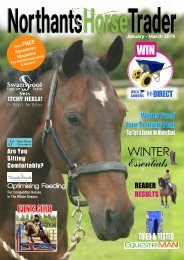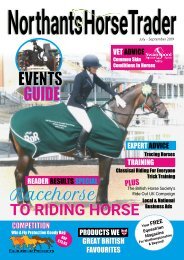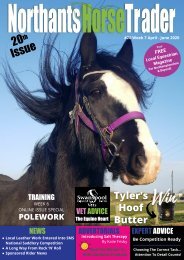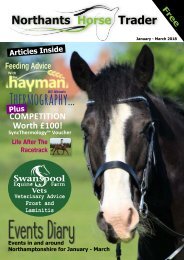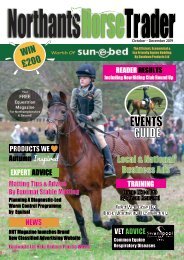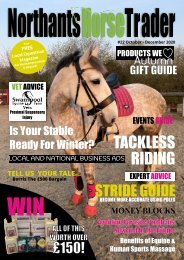NHT Magazine Autumn 2018
- No tags were found...
Create successful ePaper yourself
Turn your PDF publications into a flip-book with our unique Google optimized e-Paper software.
WORKINGWITH<br />
TRIED & TESTED<br />
‘DUNCAN’ THE DUMMY<br />
Northants Horse Trader<br />
<strong>Magazine</strong> follow many local<br />
businesses on social media<br />
and when ‘EJ’s Equestrian’ a<br />
local breaking in and reschooling<br />
business posted about the work<br />
they carry out using ‘Duncan’<br />
we were keen to find out more.<br />
Ellie has many years experience with breaking in and reschooling horses.<br />
The process can be stressful for some horses (and trainers!). Ellie was<br />
keen to look at ways she could minimise the stress of the horses that<br />
she worked with; after some research Ellie decided to import a dummy from<br />
a company called Ardall based in Ireland that she affectionately calls ‘Duncan’.<br />
The Ardall is a device for training horses. Designed primarily to accustom<br />
unbroken horses, or horses that have not been ridden for some time, to safely<br />
accept a rider, it can also be used for training performance horses.<br />
The Ardall Comprises of Four Main Parts:<br />
1. The Torso.<br />
The main part of the product resembles a legless,<br />
human torso with short arms. At its core, there is a<br />
coiled spring, which facilitates movement when<br />
mounted on a horse. This spring is enveloped with<br />
medium-grade foam in the shape of a torso, which<br />
is covered with high quality, UV-protected<br />
leatherette.<br />
2. The Base<br />
The torso is affixed to a flat, solid base, which<br />
has been specially moulded to fit any standard<br />
saddle. This is covered in the same leatherette<br />
as the torso. On either side, there are two<br />
straps - used for securing the Ardall onto the<br />
horse - and one screw-on ring, through which<br />
the reins go during lunging and long-reining.<br />
3. The Harness<br />
An essential component of the product when<br />
in use, the harness fits onto the torso. The<br />
extent to which the Ardall moves when<br />
mounted on a horse is regulated by the<br />
tightness or looseness of the harness.<br />
4. Weights<br />
These weights serve to make the Ardall heavier helping to introduce the<br />
horse to the sensation of a rider’s legs on either side. These take the form of<br />
two boot-shaped canvas bags, which are filled evenly with fine sand (up to 2<br />
stone/12.7KG in each.) These are clipped onto the Ardall, one on each side,<br />
and secured with straps. We also add a riding hat to him to make him seem<br />
more realistic.<br />
You can find out more about the Ardall dummy by visiting www.ardall.com<br />
Ellie believes she has reduced the stress levels of the horses she works with<br />
significantly. Ellie told us that this method has in her opinion “proved to be a<br />
much kinder transition to the riding experience for the horse”. Ellie added “I<br />
feel that as well as being kinder, it is a much kinder method to start a young<br />
horse or to restart a problem horse. Some horses do not like the sensation<br />
of legs when they first touch their sides, or the height of a rider above and<br />
behind the back of their heads. I find that using ‘Duncan’ helps to desensitise<br />
them before a rider gets onboard and therefore minimises injury to both horse<br />
and rider. It also initially eliminates the pull on the horses mouth, when and<br />
if they react”.<br />
Firstly Ellie begins the work by introducing the basic ground work, such as<br />
lunging, long reining and wearing tack. After the basic training, it's then a<br />
natural progression to ‘Duncan’ the dummy.<br />
The timescale varies with each horse as to how long they take to accept<br />
‘Duncan’, it can be as little as 10 minutes to start with up to 45 minutes. Ellie<br />
finds that 2-5 days use is all that is usually needed in most cases.<br />
Backing a young horse or retraining horses does require experienced and<br />
knowledgeable handling as every horse is different and you need that<br />
knowledge to be able to adapt to each situation and to keep both horse and<br />
rider safe and calm.<br />
Ellie always uses ‘Duncan’ initially on every horse or pony that comes to<br />
her to be backed or restarted in their ridden career; as she never knows<br />
how each horse is going to react and it's just a safer and kinder start.<br />
Breaking & Schooling<br />
An accomplished local rider with<br />
many years experience, I have<br />
produced horses from ride and<br />
drive, competition ponies, hunters<br />
to Eventers. Based in Ringstead,<br />
Northamptonshire, I am able to<br />
offer a variety of services:<br />
NOTE: Always seek professional advice before riding, working, training and handling horses.<br />
21 NorthantsHorseTrader <strong>Magazine</strong> Feature enquiries: features@nhtmagazine.co.uk





